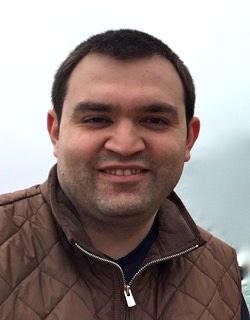Nelson Lourenco, Reza Pourabolghasem, and Dogancan (Can) Temel were chosen for Sigma Xi Best Ph.D. Thesis Awards, which were presented at the Georgia Tech Sigma Xi Awards Banquet on April 18. All three are recent graduates of the School of Electrical and Computer Engineering (ECE).
Nelson Lourenco, Reza Pourabolghasem, and Dogancan (Can) Temel were chosen for Sigma Xi Best Ph.D. Thesis Awards, which were presented at the Georgia Tech Sigma Xi Awards Banquet on April 18. All three are recent graduates of the School of Electrical and Computer Engineering (ECE).
Lourenco’s thesis is entitled “Mitigation of Transient Radiation Effects in Advanced Silicon-Germanium Technologies.” The need for low-cost electronics in extreme environment applications, such as in-orbit and interplanetary spacecraft, has brought silicon-germanium (SiGe) technologies into the spotlight, but the viable long-term capability of these semiconductor platforms in radiation-intense environments remains largely unexplored. Conventional design methodologies for radiation-hardened electronics rely on multiple system redundancies and metallic shielding, but these solutions come at severe size, weight, and cost penalties. The objective of this thesis is to explore the mechanisms of radiation effects within modern SiGe technologies and develop novel, low-overhead techniques for mitigating radiation-induced damage within these silicon-based platforms. Advised by ECE Professor John D. Cressler, Lourenco graduated in May 2016 and is now a research engineer II at the Georgia Tech Research Institute’s Advanced Concepts Laboratory in Atlanta.
Pourabolghasem’s thesis is entitled “Pillar-based Phononic Crystal Structures for High-frequency Applications.” In this thesis, a novel high-frequency signal processing platform is developed by harnessing the propagation of acoustic waves using a composite material structure known as pillar-based phononic crystals (PnCs). A major property of PnCs is their ability to stop acoustic waves within certain frequency ranges known as bandgaps. In this work, the theoretical origins of bandgap formation in the pillar-based PnCs is studied and the existence of such bandgaps and other wave-manipulating devices, such as waveguides, in the ultra high-frequency range is experimentally demonstrated. Considering the significance of fast signal processing platforms in telecommunications applications, the findings in this thesis open a new avenue in developing functional devices using PnC structures for such applications. Advised by ECE Professor Ali Adibi, Pourabolghasem graduated in May 2016 and is a data scientist with Electronic Arts in Redwood City, California.
Temel’s thesis is entitled “Understanding Perceived Quality through Visual Representations.” His research is focused on understanding the human vision system to design algorithms that perceive the world as humans do. Specially, he worked on understanding and measuring perceived quality. Temel is one of the very few, if any, in the community who possesses a strong understanding of the subject with thorough comprehension of the various directions the community has followed over the years. This unique understanding has a great potential of producing new paradigms that can affect our daily lives, including but not limited to, sharing higher quality images and videos with less data in apps like Snapchat or Facebook, having a better quality of experience while watching Netflix or YouTube, and enabling more reliable driving assistance and tele-medicine systems that can increase the quality of life for all of us. Advised by ECE Professor Ghassan AlRegib, Temel graduated in December 2016 and is a postdoctoral fellow in the Multimedia and Sensors Lab in the Georgia Tech School of ECE in Atlanta.
Additional Images


